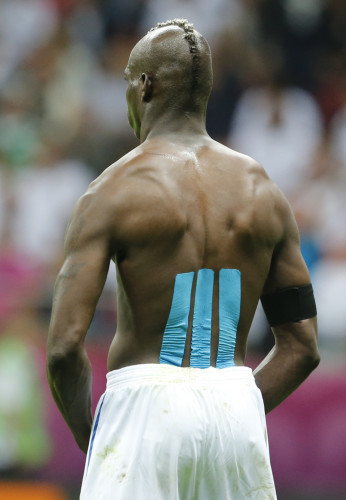BRIGHTLY-COLOURED STICKY tape plastered on the skin seems an improbable remedy for sport-related aches and pains — but it’s growing in popularity.
The Rugby World Cup was dominated by the All Blacks and if they won the battle for our hearts, kinesio tape won it for our hamstrings.
But it’s not just the patched-up rugby boys who swear by it; from the GAA men and women to soccer stars and tennis players, limbs across the sporting world have been festooned with this stuff (which isn’t cheap). But is it any good?
So, does kinesiology tape really work? Cork and Dublin-based physiotherapists Conor Gavin and Richard O’Connor weighed the claims against the evidence.
What we know:
Very little, it would appear, only that it comes in a range of colours – gaudy pink, jet black and Bombay Sapphire blue are the most common.
The people who sell it claim the tape can prevent injury, treat injury, improve blood flow and enhance performance, but we’ll come to those.
A five-metre roll of it can cost around €8 and there are now full-day courses available on how to apply it, costing upwards of €200.
What we mightn’t know:
It’s not a new trend and in fact, it was developed in the 1970s by a Japanese chiropractor named Kenzo Kase.
In short, the evidence for it isn’t exactly compelling and a recent review of it proved that in no way is it preferable to plain athletic tape for the management or prevention of sports injuries.
Physio with the Dublin ladies footballers, Conor Gavin, was inclined to agree.
The first – and most obvious question we had, was ‘is blue for girls and pink for boys?’
“From experience, the different colours mean nothing, it’s purely for fashion,” said Gavin, a physio based in Ballinteer/Dundrum.
“The tape is not really strong enough to stabilise a joint effectively. It can give proprioceptive feedback or an increased awareness to say an ankle post-sprain – but it mightn’t stop you spraining it compared to other stronger tape.
“Its main use, in theory, is to get muscles to either relax or fire up, depending on how you apply it.”
A study by Mostavavifar et al. in 2012 came to the conclusion that “this systematic review found insufficient evidence to support the use of kinesiology tape following musculoskeletal injury, although a perceived benefit cannot be discounted.
“There are few high-quality studies examining the use of kinesiology tape following musculoskeletal injury.”
Perceived benefit is an interesting slant on it, but not without merit, continues Gavin.
“K-tape may have some impact on muscle activation, purely based on being on the skin with the proprioceptive feedback that gives and the bright colours drawing your attention to it; maybe some sort of altered neutral input is provided to the muscle then. But that’s a big if.
“There’s no real evidence for it but then again, there’s no evidence for a lot of things.
“I know patients who think it’s useless and patients who swear by it.
“It won’t cause any problems to wear it and if it’s helping then great but let them know it might not actually be doing much and they’d be better off working on addressing the reasons for having it on the affected area in the first place. Physio is not a quick-fix and some tape definitely isn’t.
“In short, some physios, like patients, love it. More don’t.”
Richard O’Connor, a physiotherapist with over seven years of experience treating athletes, agrees to an extent but does see value in terms of injury treatment.
“I’d be more positive. It’s all about how it’s applied; you can’t say it’s a black or white issue. It depends on what way it’s applied and for what.
“The tape moves in one direction and has longitudinal stretch; that’s its unique selling point. It will move with you but it can stop you moving too.
“It can facilitate movement better than some other forms of tape but can limit movement also.
“The amount of stretch is another issue; it stretches to a certain amount and in this way you can apply it to achieve a treatment goal.
Technically, it can be used to block a joint if you take up the slack properly with the tape stretched.
“I see a lot of Gaelic footballers and rugby players looking to have their hamstrings taped with it. It moves so for that reason, it stays on well.
“It can give them some feedback when they’re close to over stretching but I always tell them it’s not going to stop them re-injuring their hamstring if they return to games without having the strength work done, which is the most important.”
In terms of improving performance, that’s very much a subjective issue.
A rugby player’s performance is different to analysing that of a cyclist.
In the latter, cardiovascular fitness determines the outcome, more or less. In that case, it’s impossible to draw a correlation between kinesio tape enhancing this.
However, from a psychological standpoint, kinesiology tape may help cyclists feel more supported and more confident. Related to this extra confidence, it may also have significant placebo effects, which are known to aid performance.

